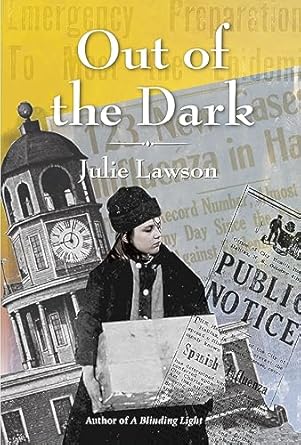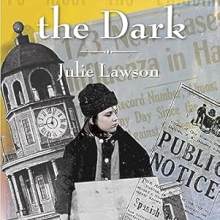Out of the Dark

Out of the Dark by Julie Lawson

Summary
A follow-up of the bestselling, Geoffrey Bilson Award — and Victoria Book Prize — nominated A Blinding Light , focusing on the aftermath of the Halifax Explosion and the onset of the Great Influenza Pandemic. When Jane Mooney's older brother Connor lies about his age and enlists in the Great War at age fifteen, she can't imagine ever being more devastated. But on December 6, 1917, when two ships collide in Halifax Harbour, the resulting explosion proves her wrong. An injured Jane awakes to discover that the North End of Halifax, including her home, has been destroyed; her father and three of her brothers have been killed; her mother, recovering from a head injury, has been left confused and forgetful; and her two surviving brothers are looking to her for guidance. Like so many Explosion survivors, Jane and her family are forced to start over. (Goodreads)
Thoughts
Out of The Dark is a sequel to Blinding Light and the two are historical novels by Julie Lawson that follows Jane Mooney and her older brother, Connor Mooney. Along the twisting paths of Halifax, Canada Connor enlists in the army in December of 1915 at age 15. This event causes Jane and Connors life to drastically change. This story follows the pair of siblings and their journey in the trenches and the new roles Jane has to take on in the wake of a catastrophic explosion. This book enraptures themes of self-growth, independence, sacrifice, and grief.
This novel had similar themes to “The Paper Girl of Paris” by Jordyn Taylor, for example, these books are filled with information and delivered their purpose in an engaging manner. The suspense that leads up to a massive event pulls the reader in and wonder about the fate of certain characters. Furthermore, there is a sense of an unspoken mystery that unfolds later on in the novel, I thought this was a clever idea since it keeps the reader guessing and inferring the meaning of certain conversations. For instance, Jane and her mother hint at her father's behaviour around the house.
In these events, Julie Lawson utilizes the characters and makes them grow or recover from immense struggle. Moreover, Jane grew from a reserved but protective older sister to a girl that took on responsibilities to keep her family surviving in the mists of a pandemic. During the middle of her character development, Jane reminded me of myself since we have similar expectations. Such as, taking care of siblings, providing for siblings when needed, preforming well in school, and helping around the house. Even though her struggles that she faces are unfathomably different, we share various qualities and have similar values. Similarly, Jane’s life at school left a substantial impact on her life, since her schooling was with children of a higher social status whether it was money or how their parents sought work. It was an immense difficulty for her to “fit in” and survive the pandemic everyone in Halifax faced.
Although this is a dual point of view, we get to hear and live through Jane’s perspective extensively since Connors point of view is his journal entries. At times, it is confusing since Jane could be cleaning around the house or lending to her mother, and the next page the font would change and it would be Connor’s journal entry. Despite this small flaw, the different perspectives were intriguing since their lives were different but similar. For example, they both had to do chores and obey the wishes of their teachers/commander.
Through the tiresome journey of Jane and Connors life, the novel was intriguing and gave the reader a taste of daily life for citizens in Halifax, Canada during the “Great War.”
Reviewed by Katie Yee
April 2025
